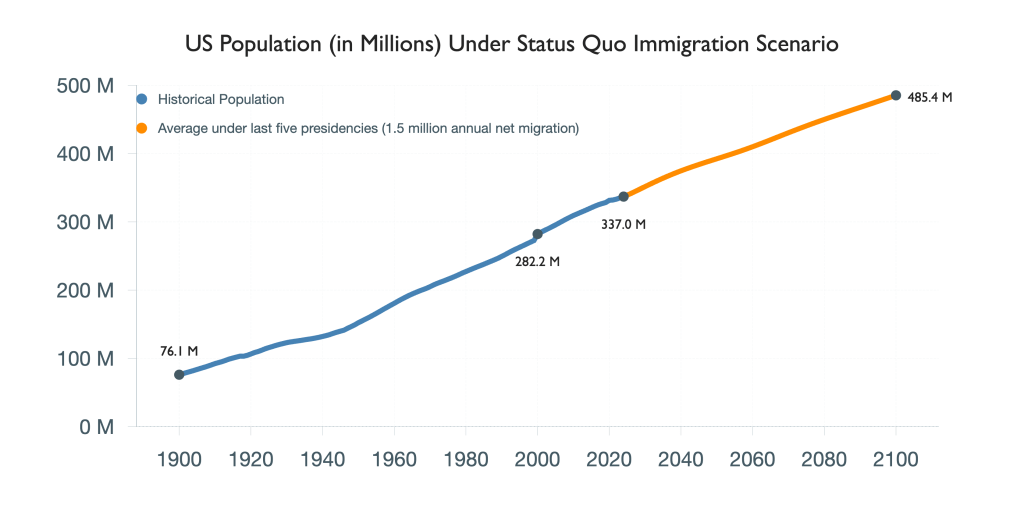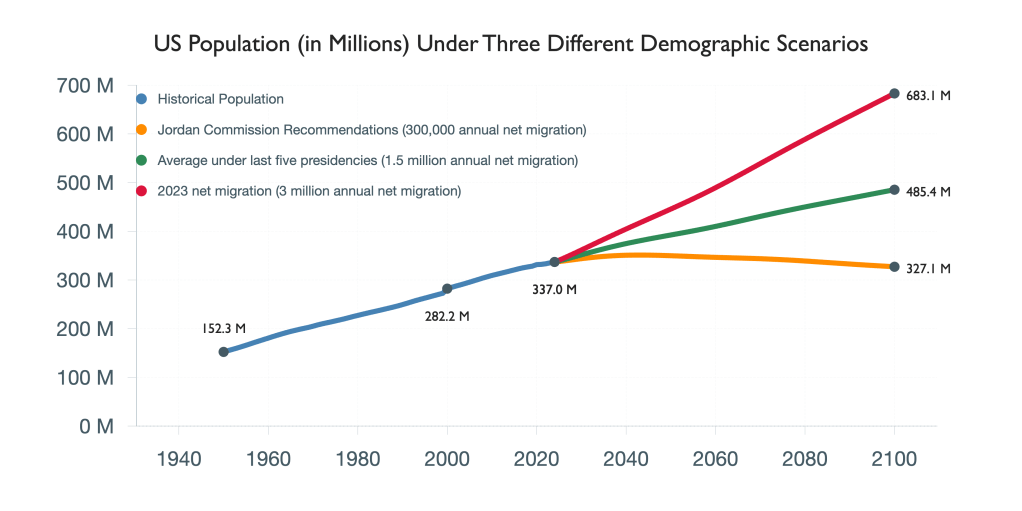

Recent Immigration Surge Has Been Largest in U.S. History, boomed an article in the New York Times last year. Net immigration levels under the Biden administration averaged nearly two and a half million annually. This drove the highest U.S. population growth in decades, according to the Census Bureau, putting us on pace to nearly double America’s population by the end of the century.
Numbers matter! To show how much they matter, NumbersUSA has created the new population projection tool below. Move the sliders to set annual numbers for legal and illegal immigration. Then see for yourself how that changes future population numbers.
By moving your cursor along the projection line, you can see total population numbers for any year between 1950 and 2100. We think you’ll be impressed by how relatively small changes in annual immigration can cumulate, leading to BIG changes to our future population.
Recent variations in U.S. immigration levels have been due primarily to federal policy changes. Legal immigration under Congressionally mandated programs has stayed relatively stable at around 1.2 million annually since the last major increases in legal immigration levels in the early 1990s. What changed dramatically during the past decade have been four things:
Policy changes can have important demographic impacts in both the short and long term. You can see this by comparing three scenarios that capture the range of immigration policy choices facing the United States.
Holding fertility and mortality rates steady across all three scenarios, we first graph a “status quo” scenario of 1.5 million annual net migration, the average over the eight administrations of the past five U.S. presidents from 1992 to the present. Projected forward, this immigration level leads to substantial population growth throughout this century, from 337 million to 485 million. That’s an increase of nearly 150 million people by 2100.

We then compare this status quo scenario to one based on the immigration levels recommended by the U.S. Commission on Immigration Reform (1997) (commonly known as the Jordan Commission) and endorsed by President Clinton (300,000 annual net) and to the highest annual net immigration level under the Biden administration (approximately 3 million in 2023).
The Jordan Commission recommendations, endorsed by NumbersUSA, would reduce immigration levels substantially, while leaving room for bringing in exceptional workers, genuine political refugees, and spousal reunification. The Biden administration’s numbers for 2023 stand as the high-water mark for immigration permissiveness, providing a real world high-migration comparison to the status quo scenario.

As you can see, implementing the Jordan Commission’s immigration levels would lead to a 3% decline in population over the next seventy-five years, from 337 million to 327 million — essentially stabilizing the U.S. population. Locking in the highest immigration levels reached during the Biden administration, in contrast, would more than double the U.S. population, which would reach 683 million in 2100 with no end to growth in sight.
These three policy scenarios are all plausible. They all have their advocates. But they put the United States on three very different population trajectories: stability, rapid growth, or very rapid growth. They differ in their 2100 population projections by 356 million – more than the entire U.S. population today!
What do you think the United States’ annual immigration level should be? Explore possible answers with our new population projection tool. Then make sure your elected representatives know what you think! Sign up for action alerts from NumbersUSA, your advocate for sensible immigration policies.